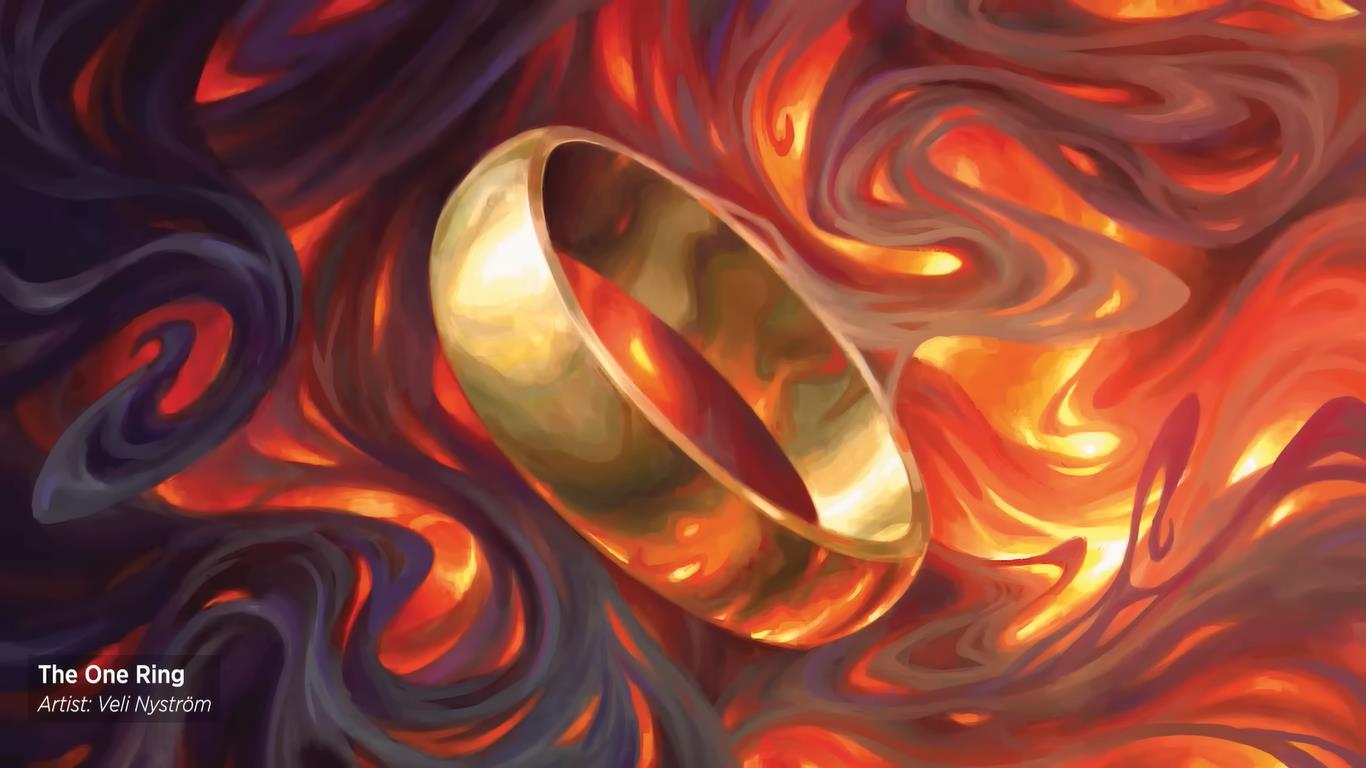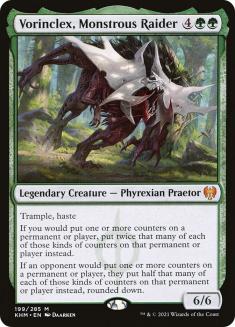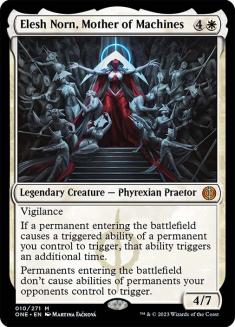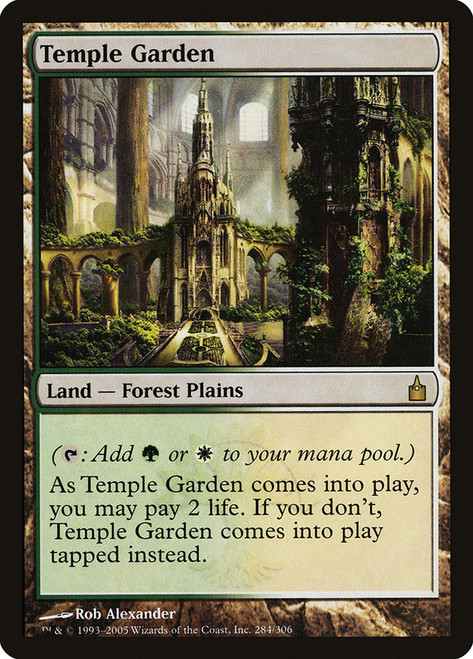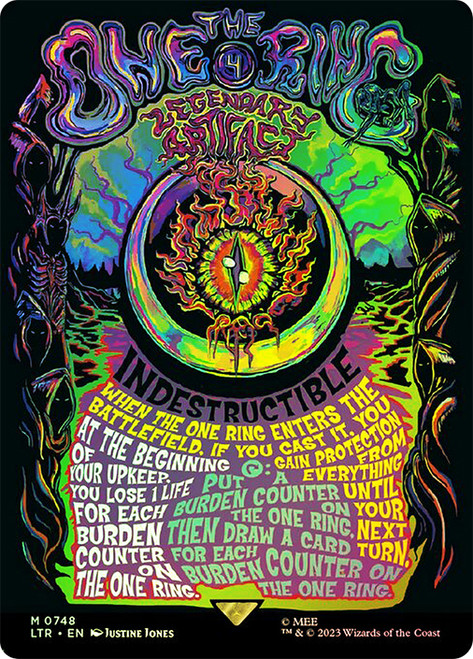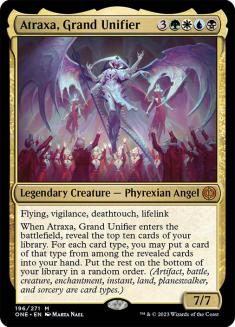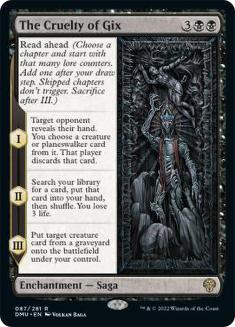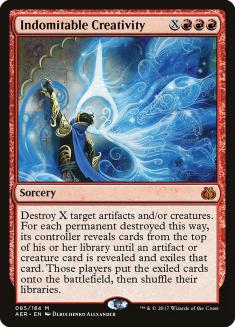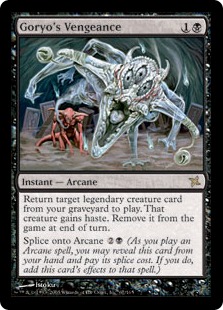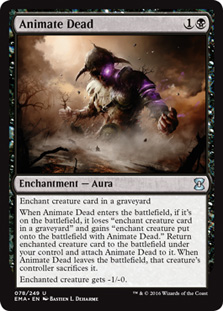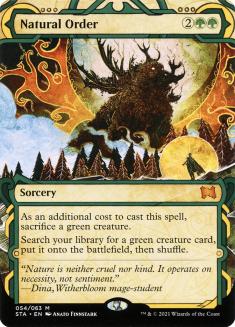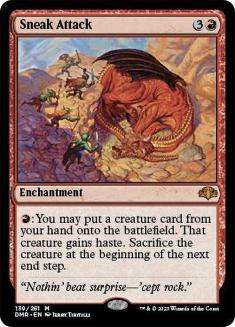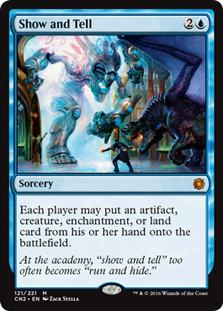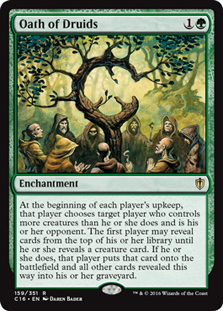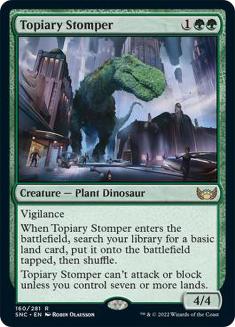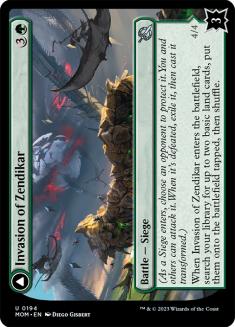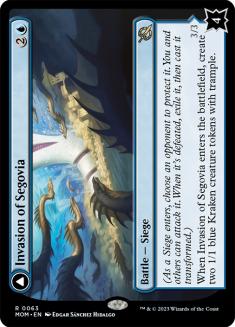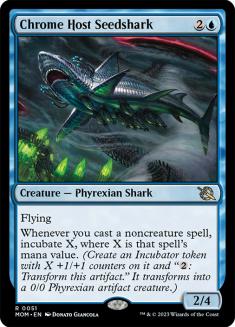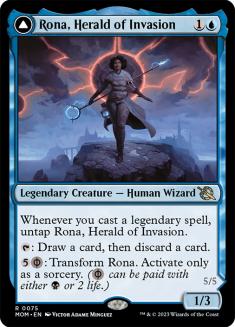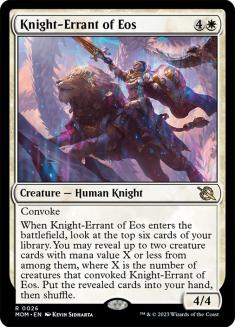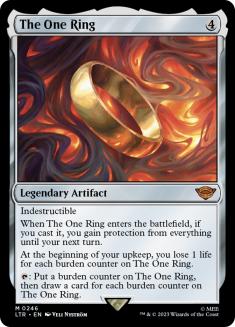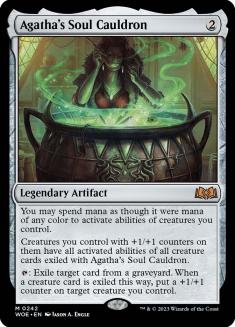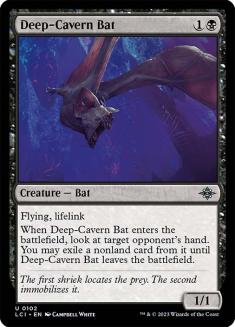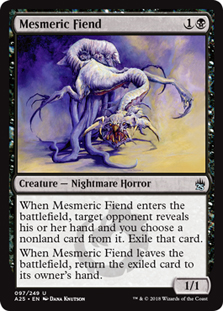2023 was a long and big year for Magic. Whatever your involvement with the game and however you identify as a player, there was an endless torrent of new product and content. Standing out in that crowd is hard, but it’s worth remembering the big hits and misses from each set.
Phyrexia: All Will Be One
The first half of the year gave us the payoff for the grand Phyrexia plot arc that had been building towards this crescendo for a while now. We didn’t know what to make of a very out-of-place Vorinclex, Monstrous Raider appearing on Kaldheim a few years ago, but we knew something bad was brewing. After a steady drip of ill omens since then, Phyrexia: All Will Be One took us back to Mirrodin Pure New Phyrexia for the unveiling of Elesh Norn’s plans for total domination.
Elesh Norn herself embodied the best and worst of this set. You want the main storyline characters to be important in the saga unfolding across the table or on your screen, too, and Elesh Norn managed that – though without conquering all of the Commander universe, too as some of its luminaries feared. In Constructed, she interestingly made more of a mark in Pioneer and Modern than in Standard. Still, getting a five-mana finisher to show up in those formats at all is easier said than done, so that’s a consolation prize of sorts after her failed insurrection.
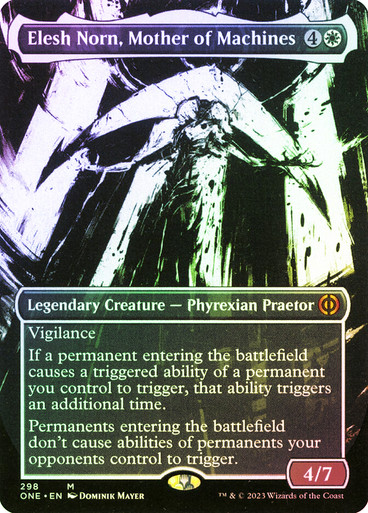
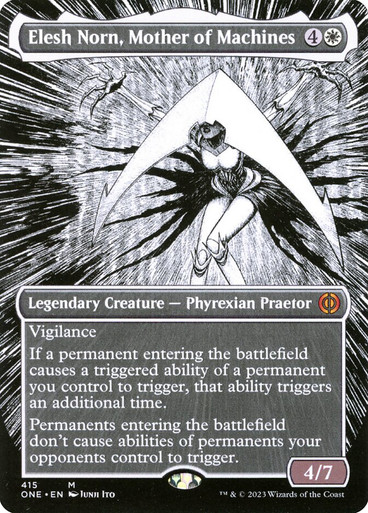
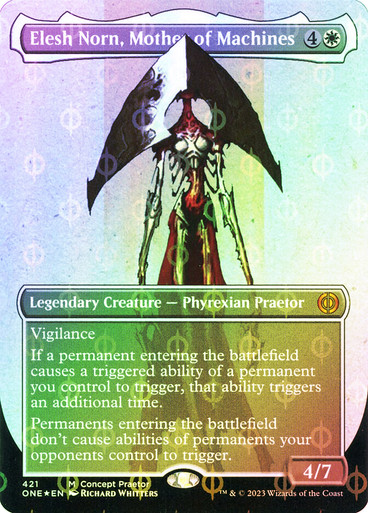
Do you ever wonder if you can have too much of a good thing? The proliferation of alternate art treatments and styles reached even more dizzying heights this year, and the Mother of Machines is the most absurd and extreme example. This is great material for writers who need to fill out their power rankings articles – ‘Top 10 Elesh Norn, Mother of Machines varieties‘ is such low-hanging fruit that it’s already underground in the Lost Caverns of Ixalan – but it’s a nightmare for collectors or retailers who have to carefully catalog every SKU, to say nothing of coverage announcers and viewers who have to process a game state where any card could have several arts with totally different styles.
Who is this for? You can grade each version individually – Phyrexian language Elesh Norn makes sense, ‘standing against a plain background for her passport photo’ Elesh Norn does not – but it’s not about any one art or the exact count of different arts. Alternate art used to feel special or significant – these days, a card not having multiple versions stands out more. At its best, this can be yet another form of self-expression for players. Taken to this extreme, it damages any sense of shared aesthetics or world-building within a set and more broadly.
Take an iconic card and image as an example. Ravnica: City of Guilds took me from a new and curious Magic player to a lovestruck addict with its gorgeous art and compelling flavour. I still remember the first time I set eyes on Rob Alexander’s incredible art for Temple Garden during preview season, and a print of that art hangs on my wall at home to this day. In just a few days, Ravnica Remastered aims to cash in on nostalgia like that from boomers like me with the original shockland art in the old Magic frame for the first time.
Each successive block set in Ravnica has brought a new, less inspiring art for Temple Garden. Unfinity needed some hook to drive sales, so here’s Temple Garden… in space (day-time and night-time arts available!). The Zendikar Expedition Temple Garden is a more abstract mess of hedrons that doesn’t look like a temple or a garden, but does look like every other interchangeable Expedition that caused such headaches on coverage for the SCG Tour. Nobody asked for most of this – and, when a special piece does show up, it gets lost in the shuffle with less time to soak it in before the next deluge of arbitrary stuff.
Even the mediocre Temple Garden or Elesh Norn arts ‘look like’ Magic cards. Some of the more baffling knockoffs can’t clear that low bar. The ‘poster art’ cards are illegible as game pieces, but also total failures aesthetically – unlike a real poster, nobody wants that on their wall.
Back in the oil wells of Phyrexia, another queen stole Elesh Norn’s thunder:
Atraxa, Grand Unifier was a game-changer across all Constructed formats. If you’re trying to cheat a big creature into play – in any format, from any zone, with any method – Atraxa is usually the best default if it’s eligible.
Her size and stats let her stabilize and dominate almost any battlefield state, while her card selection is a unique and impressive way to set up your next threat, find that critical piece of interaction for theirs, or just bury the opponent in card advantage. Her mix of colours makes her the perfect sacrifice for pitch cards in larger formats, from Grief and Solitude in Modern to Force of Will and Force of Vigor in Legacy or Vintage.
In some contexts, this was a welcome upgrade. Atraxa outmuscled Griselbrand and all other contenders to become the Oath of Druids hit of choice in Vintage. In others, Atraxa revived old strategies or spawned entirely new ones. It may seem like a blow to diversity that Atraxa ended debates about which creature to smuggle in, but some of those decks failed because they had no good answers before. They certainly do now!
Of course, in formats where you have time to just cast seven-drops, Atraxa is the best at that too. Atraxa is central to Domain Ramp’s stranglehold over The Lost Caverns of Ixalan Standard heading into this season of Regional Championship Qualifiers.
Our short stay on Phyrexia didn’t stir many emotions in me. Toxic is an interesting riff on infect, but the themes and mechanics were largely derivative of New Phyrexia, which already exhausted most of their potential. The Draft format was very poorly received and became a case study for many players’ complaints about recent Limited design. We got the gist early and were ready to move on to the grand finale this set introduced.
March of the Machine
If All Will Be One felt like more of the same, March of the Machine was everything everywhere all at once, and a totemic moment for Magic lore and design alike – Avengers: Endgame, but with more Vampires riding Dinosaurs. If you felt attached to some random secondary character from an abandoned plane, this was your best chance to see them in action again. Anyone could find a lot to love, but not much of any one thing – by necessity, its commitment to any one idea was shallow.
This set was so busy that the introduction of the first new card type in over fifteen years felt almost like an afterthought and didn’t leave a lasting impression. We were told not to expect battles to show up constantly, but this initial, cautious experiment went well, and I’m keen to see how they mine that design space more.
Despite the return of so many characters and planes, the designers wisely resisted the temptation to go full Future Sight and bring back a million mechanics. The new ones here landed well, with the unassuming backup in particular enriching Limited gameplay. Convoke is always a safe bet, but the bigger achievement here was taming Phyrexian mana and using its talents for good. These examples of each are some of the set’s home runs.
The last ambitious crossover episode was all about planeswalkers – these days, they are less present in Magic than at any point in the past decade. An original, powerful planeswalker design now feels like a rare and exciting treat rather than an entitlement. Chandra, Hope’s Beacon promises you a great time and delivers on that, yet makes you work for it, unlike the overperforming but boring big hitters like Teferi, Hero of Dominaria or Gideon, Ally of Zendikar.
March of the Machine: The Aftermath
The most baffling product in a year with a lot of releases, March of the Machine: The Aftermath had no clear purpose. The main set was so busy that it could have easily filled a second set in the old block structure, but this wasn’t that. From the other direction, very few sets could have used some extra time to let the cards breathe and let the players digest it and recover more than March of the Machine – instead, this gave them less! The Commander releases paired with every mainstream set already catch the designs that are on-theme but too pushed or experimental for normal Constructed.
There are some strong cards and even more weird cards in this little expansion, but mentioning them by name would give this more legitimacy than it deserves. Let’s move on.
The Lord of the Rings: Tales of Middle-earth
This summer saw the biggest test yet for Universes Beyond. The Lord of the Rings: Tales of Middle-earth had to translate a beloved franchise with extensive lore and world-building into a fully fleshed out Magic set. Competitive players had reason for interest too – this was a straight-to-Modern set headlining the first Modern Pro Tour since Modern Horizons in 2019.
This set aced that first test. Fans of Tolkien’s work overwhelmingly liked its representation here, and sales were phenomenal. That success may worry you if you have an ideological objection to Universes Beyond and its expanding role in Magic – this will be used to justify all kinds of UB crossovers that are a lot more messy and jarring than this one – but this set is now a useful template for how to do things well.
Ultimately, Middle-earth worked in part because it could feel like any other Magic set. The high fantasy setting matches the tone of early Magic – Human Knights, Elves and Orcs, magical artifacts and mysterious lands – in a way that Tony Stark strolling through New York does not. Even if the much-awaited Marvel crossover is technically well-executed, the aesthetics are unsalvageable.
Fittingly, the namesake of The Lord of the Rings is the card of the set, and gets my vote for card of the year.
You want the game pieces that embody named, central characters to be appealing, and The One Ring understands that all too well. Watching the card be ignored at first and then cause mass hysteria on its release as its power became too obvious to ignore and every deck warped itself to include it – with only some proving skilled enough to keep it – was a vindication of the whole concept. The details of that power raised some flavour questions – why does the wording make it so that you want to play and draw as many copies as possible, and why do you have control over how much it escalates its corruption? – but it did its job. All eyes, fiery and human, were on The One Ring heading into the Pro Tour.
It would be my card of the year for that alone, but the extracurricular nonsense with The One Ring and its seven-figure price tag – which, as in the books, was cast by Post Malone into a safety deposit box – makes that a lock.
Wilds of Eldraine & The Lost Caverns of Ixalan
We went back to form for the rest of the year with returns to two planes that earned bad reputations for very different reasons. Throne of Eldraine overwhelmed an appealing setting and mechanics with power creep that derailed all of Magic for years; Ixalan was a fan service world that still didn’t excite anyone because the cards were so poor.
Wilds of Eldraine and The Lost Caverns of Ixalan show how to fix those mistakes and build on the successes of the first visits at a more normal power band. The new mechanics in each are either too safe to get you going or too wordy to be worth the effort, but the basic recipe is sound.
My highlight from Wilds of Eldraine is one of the most creative combo enablers of all time. As a cheap artifact that carries incidental graveyard hate, Cauldron is a fantastically flexible card that doesn’t need much justification, but it also lets you chase some unique dreams. Some decks, like Golgari Yawgmoth in Modern or Kethis Combo in Historic, use Cauldron as a backup combo piece that makes you more resilient; others, like the Standard Simic Cauldron decks that broke out at Worlds, use Cauldron as their focus to graft a unique blend of abilities onto a creature to create lethal loops. I’m still trying to crack the code on Cauldron + Griselbrand in Modern…
In a change of pace from Cauldron and the other all-stars I’ve mentioned, my pick from The Lost Caverns of Ixalan is the innocuous Deep-Cavern Bat. Mesmeric Fiend was a fan favourite that many players overrated and others turned to out of necessity, but the various riffs on that card over the years have failed to reach the mainstream.
Fiend’s fragility is the whole point, but that rendered it immobile – it could rarely justify attacking or blocking if the battlefield contained anything at all. Bat’s stats are the same, but flying and lifelink make it a much more dynamic game piece, encouraging you to find ways to boost its power. Power creep at the top can be dangerous, but thoughtful improvement to popular role-players like this is welcome and necessary as the card pool keeps expanding.

